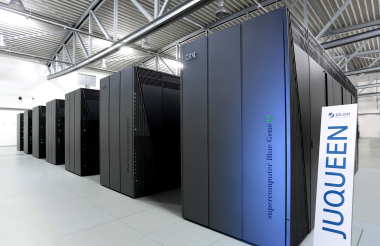Selected Offers and Areas of Expertise
How do complex liquids and soft matter behave under the influence of external forces? How dependent are the properties and functions of macromolecular materials, such as starch or protein molecules, on their inner structure and molecular processes? We attempt to answer these and other challenging questions which span the fields of physics, chemistry and biology.
To this end, we develop and employ a wide range of the most advanced instruments, experimental approaches and theoretical methods for our research. In collaborations with leading research facilities and companies in industry, we are able to share our knowledge and also pass it on to the next generation of young scientists in the form of lectures, study programmes and summer schools.
Below, you can find a selection of the facilities, activities and educational events on offer. Further details are given on the websites of the individual institutes.
Methods and Infrastructure
Biomolecular NMR Center
The Biomolecular NMR Centre of IBI-7 and the Institute of Physical Biology at the Heinrich Heine University Düsseldorf Heinrich-Heine-Universität Düsseldorf , with its high field NMR spectrometers for fluid and solid state NMR spectroscopy, offers excellent opportunities for research into structural biology on biologically and medically-relevant proteins, such as the identification of high-resolution, three-dimensional structures.
Serving science, side by side
Our administrative staff provides advice and support in all matters concerning personnel, order processing, public relations and much more. Our engineers and mechanics work closely with scientists; our programmers and IT specialists offer technical advice, develop device drivers and control software as well as imaging techniques for real-time simulations. IBI-4 is supported by the Technical Services and Administration department PGI/JCNS-TA. IBI-2 and -3 are supported by the Technical and Administrative Infrastructure IBI-TA.
Jülich Centre for Neutron Science (JCNS)
We develop and operate neutron scattering instruments at some of the best neutron sources worldwide: FRM-II (Garching), ILL (Grenoble), SNS (Oak Ridge) and in the future at the European Spallation Source ESS (Lund). Our research focus areas are “soft matter and biophysics”, “correlated electron systems and nanomagnetism” and “energy materials”. Within these areas of expertise we offer expert support at world-class neutron instruments including a specialized sample environment and ancillary laboratory access for external users from science and industry.
Helmholtz Nanoelectronic Facility (HNF)
The Helmholtz Nanoelectronic Facility (HNF) at the Forschungszentrum Jülich is a state of the art clean room facility with 1000 m2 clean room space DIN ISO 1-3 and forms the central technological platform for nanoelectronics with an emphasis on “green microchips/computing”, quantum- and neuromorphic computing, bioelectronics and microfluidics in the Helmholtz Association.

Jülich Supercomputing Center (JSC)
The Jülich Supercomputing Center (JSC) operates supercomputers of the highest performance class, which enable scientists and engineers to solve highly complex problems by simulations. The institute IBI and the program BioSoft benefit enormously from the high-performance computing facilities of JSC and the periodic performance upgrades. Many of the simulation activities, ranging from molecular dynamics simulations of proteins to mesoscale simulations of complex fluids and active systems, require large computer resources due to the large number of degrees of freedom, the large number of interacting components, and the wide range of relevant time scales. For example, JSC’s simulation lab on molecular systems offers a code for efficient computation of long-distance interactions that is highly beneficial for simulating soft matter systems with electrostatic contributions. In addition, the computer department of the Peter-Grünberg Institute (PGI) operates CPU and GPU clusters for the three theory groups PGI-1, PGI-2, and IBI-5. These clusters are ideally suited for medium-size simulations with optimized software.
Methods
Synchrotron Scattering
We use synchrotron X-ray beamlines at the storage rings PETRA-III (Hamburg) and ESRF (Grenoble) to determine the structure of soft materials and proteins. We develop specialized sample environments including shear cells and microfluidic devices together with in-situ spectroscopic techniques for fast time-resolved in-situ X-ray scattering experiments.
Collaborations
Softcomp started out as a Network of Excellence (NoE), supported by the EU with the aim of creating a sound knowledge base for the intelligent design of functional composite soft matter materials on the nanoscale.
EUSMI (European Soft Matter Infrastructure) is the European infrastructure project for soft matter (in the Horizon 2020 EU program), is coordinated by IBI-4. A total of fifteen European partners pool their facilities for undertaking physical studies on soft matter, for developing and synthesizing new materials and computer simulations, and will make this infrastructure available to external scientists for their research work.
Educational Programmes and Events
The International Helmholtz Research School of Biophysics and Soft Matter (IHRS BioSoft) offers excellent research opportunities for students working on their doctoral thesis.









